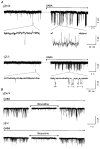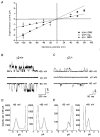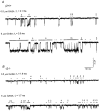Single-channel properties of neuronal GABAA receptors from mice lacking the 2 subunit
- PMID: 10944167
- PMCID: PMC2270058
- DOI: 10.1111/j.1469-7793.2000.t01-1-00011.x
Single-channel properties of neuronal GABAA receptors from mice lacking the 2 subunit
Abstract
1. The aim of this study was to define the biophysical properties contributed by the gamma2 subunit to native single GABAA receptors. 2. Single-channel activity was recorded from neurones of wild-type (gamma2+/+) mice and compared with that from mice which were heterozygous (gamma2+/-) or homozygous (gamma2-/-) for a targeted disruption in the gamma2 subunit gene of the GABAA receptor. Unitary currents were evoked by low concentrations of GABA (0.5-5 microM) in membrane patches from acutely isolated dorsal root ganglion (DRG) neurones (postnatal day 0) and by 1 microM GABA in patches from embryonic hippocampal neurones which were cultured for up to 3 weeks. 3. GABAA receptors from DRG and hippocampal neurones of gamma2+/+ and gamma2+/- mice displayed predominantly a conductance state of 28 pS and less frequently 18 and 12 pS states. In gamma2-/- mice, conductance states mainly of 12 pS and less frequently of 24 pS were found. 4. The mean open duration of the 28 pS state in gamma2+/+ GABAA receptors (1.5-2.6 ms) was substantially longer than for the 12 pS state of gamma2-/- GABAA receptors (0.9-1.2 ms) at all GABA concentrations. For gamma2+/+ and gamma2-/- channels, the mean open duration was increased at higher GABA concentrations. 5. Open duration frequency distributions of 28 and 12 pS receptors revealed the existence of at least three exponential components. Components with short mean durations declined and components with long mean durations increased in relative frequency at higher GABA concentration indicating at least two binding sites of GABA per 28 and 12 pS receptor. 6. Shut time frequency distributions revealed at least four exponential components of which two were identified as intraburst components in 28 pS and one in 12 pS GABAA receptors. 7. The mean burst duration and the mean number of openings per burst increased in 28 and 12 pS GABAA receptors with increasing GABA concentration. At least two burst types were identified: simple bursts consisting of single openings and complex bursts of five to six openings in 28 pS but only two to three openings in 12 pS GABAA receptors. 8. We conclude that the gamma2 subunit enhances the efficacy of GABA by determining open conformations of high conductance and long lifetime, and by prolonging the time receptors remain in the activated bursting state.
Figures









References
-
- Amico C, Cupello A, Fossati C, Robello M. Involvement of phosphatase activities in the run-down of GABA(A) receptor function in rat cerebellar granule cells in culture. Neuroscience. 1998;84:529–535. - PubMed
-
- Barnard EA, Skolnick P, Olsen RW, Mohler H, Sieghart W, Biggio G, Braestrup C, Bateson AN, Langer SZ. International Union of Pharmacology. XV. Subtypes of gamma-aminobutyric acidA receptors: classification on the basis of subunit structure and receptor function. Pharmacological Reviews. 1998;50:291–313. - PubMed
-
- Benke D, Honer M, Michel C, Mohler H. GABAA receptor subtypes differentiated by their gamma-subunit variants: prevalence, pharmacology and subunit architecture. Neuropharmacology. 1996;35:1413–1423. - PubMed
Publication types
MeSH terms
Substances
LinkOut - more resources
Full Text Sources
Molecular Biology Databases

